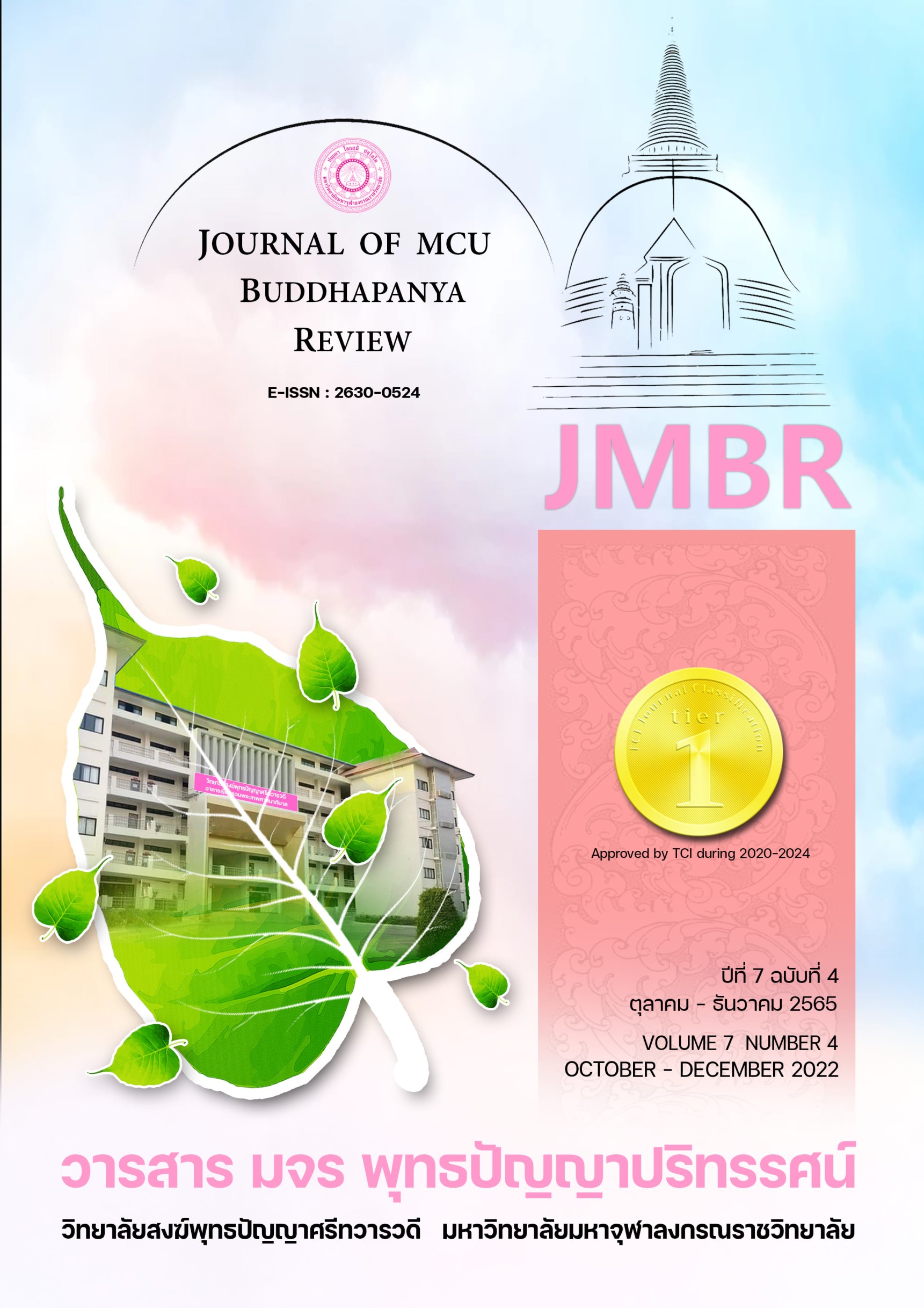แนวทางการพัฒนาพื้นที่การขนส่งทางอากาศสู่ความสำเร็จของอุตสาหกรรม การขนส่งทางอากาศระหว่างประเทศ
คำสำคัญ:
แนวทางการพัฒนา, พื้นที่การขนส่งสินค้าทางอากาศ, อุตสาหกรรมการขนส่งสินค้าทางอากาศระหว่างประเทศบทคัดย่อ
บทความวิจัยนี้วัตถุประสงค์เพื่อ 1) เพื่อศึกษาลักษณะการพัฒนาพื้นที่การขนส่งสินค้าทางอากาศสู่ความสำเร็จของอุตสาหกรรมการขนส่งสินค้าทางอากาศระหว่างประเทศ และ2) เพื่อสร้างแนวการพัฒนาพื้นที่การขนส่งสินค้าทางอากาศสู่ความสำเร็จของอุตสาหกรรมการขนส่งสินค้าทางอากาศระหว่างประเทศ เป็นการวิจัยเชิงคุณภาพเครื่องมือที่ใช้คือแบบสัมภาษณ์โดยผู้ให้ข้อมูลสำคัญ แบ่งออกเป็น 3 กลุ่ม ได้แก่ กลุ่มผู้รับบริการ กลุ่มผู้บริหารและส่วนราชการที่มีประสบการณ์เกี่ยวกับด้านการขนส่งสินค้าทางอากาศระหว่างประเทศรวมทั้งสิ้นจำนวน 23 คน ผลการศึกษาพบว่า ด้านลักษณะการพัฒนาพื้นที่การขนส่งสินค้าทางอากาศ มีวิสัยทัศน์นโยบายและเป้าหมายเพื่อสร้างศูนย์กลางการขนส่งสินค้าทางอากาศ และศูนย์กลางด้านโลจิสติกส์ มีระเบียบ และกฎหมายสอดคล้องกับยุคสมัยปัจจุบัน รองรับการพัฒนาเป็นศูนย์กลางด้านโลจิสติกส์ ด้านการพัฒนาโครงสร้างพื้นฐานของการขนส่งสินค้า ในส่วนการบริหารจัดการ คือ ผู้บริหารมืออาชีพมีทักษะ และความสามารถในการบริหารจัดการพื้นที่อย่างประสิทธิภาพ มีความพร้อมด้านบริหารงานบุคลากร มีการจัดการด้านการตลาดและประชาสัมพันธ์ภาพลักษณ์ที่ดีของพื้นที่ขนส่งสินค้าทางอากาศ ด้านปัจจัยภายนอกของการบริหารจัดการ คือ ปัจจัยเศรษฐกิจที่เกิดจากผลกระทบของโรคโควิด-19 ด้านการเมือง/กฏหมายและการเปลี่ยนแปลงนวัตกรรมและเทคโนโลยี ลำดับที่สอง ความสำเร็จของอุตสาหกรรมการขนส่งสินค้าทางอากาศระหว่างประเทศ ปัจจัยหลัก ข้อมูลบริบททั่วไปของอุตสาหกรรมการพัฒนาพื้นที่การขนส่งสินค้าทางอากาศ ได้แก่ เป้าหมาย/นโยบาย ปัญหาและอุปสรรค ระเบียบ/กฎหมาย และคุณภาพการบริการส่งผลโดยตรงต่อการบริหารจัดการภายในของพื้นที่การขนส่งสินค้าทางอากาศ ได้แก่ ความสามารถในการบริการ ความสามารถในเชิงนวัตกรรม ความไว้วางใจ ในด้านปัจจัยเกื้อหนุนคือปัจจัยภายนอกได้แก่ ปัจจัยด้านเศรษฐกิจ ปัจจัยการเมือง/กฎหมาย ปัจจัยด้านนวัตกรรมและเทคโนโลยี ในด้านกระบวนการคือการบริหารจัดการ ได้แก่ ผู้บริหารมืออาชีพ การบริหารการตลาดและการบริหารงานบุคคล ส่งผลต่อความสำเร็จ ได้แก่ การเป็นศูนย์กลางการขนส่งสินค้าและศูนย์กลางโลจิสติกส์ความเชื่อมั่นในคุณภาพ และสถานภาพทางการตลาด
เอกสารอ้างอิง
Chitpong Ayasanond. (2018). The Service Management that Affect Supply Chain Performance of Freight and Mail Management of Thai Airways International Public Company Limited. (Doctor of Philosophy Program in Logistics and Supply Chain Management). Bangkok: Sripatum University.
Department of Business Development. (2019). Logistics Business It's Time For Thailand To Adapt - Change The Way Of Thinking, Use Technology To Help Manage And Turn Competitors Into Alliances. Retrieved on 1 February 2021. From https://www.dbd.go.th/news_view.php?nid=469414627
Heizer, J., & Render, B., & Munson, C. (2017). Operations management: Sustainability and supply chain management (12th ed). Essex: Pearson Education.
Logistics Division Department of Industrial Promotion. (2019). Logistics efficiency metrics factors for success. Retrieved on 1 February 2021. Fromhttps://dol.dip.go.th/th/category/2019-02-08-08-57-30/2020-03-15-09-09-00.
Ministry of Industry. (2017). Aviation and Logistics Industry Is One of the Five Future Industries. (New S-curve). Retrieved on 1 February 2021. From http://www.industry.go.th/center_mng/index.php
Phuwana Asawakonnirangkun. (2019). Adaptation of Thai Logistics Transportation Service Provider in the Digital Age. Journal of Humanities and Social Sciences, Rajapruk University, 5(supplement), 15–29.
Porter, M.E. and Kramer, M.R. (2006) Strategy & Society: The Link between Competitive Advantage and Corporate Social Responsibility. Harvard Business Review, (84), 78-85.
Sathaporn Opasanon. (2021). Logistics management in pandemic crisis. Covid- 19 Business Survival by TBS. Bangkok: Thammasat University.
Wimol Phasathuen. (2018). Factors in Fluencing the Competitive Advantage of Thai Airfreight Forwarders. (Doctor of Philosophy in Social Sciences). Bangkok: Ramkhamhaeng University.
ดาวน์โหลด
เผยแพร่แล้ว
รูปแบบการอ้างอิง
ฉบับ
ประเภทบทความ
สัญญาอนุญาต
ลิขสิทธิ์ (c) 2023 วารสาร มจร พุทธปัญญาปริทรรศน์

อนุญาตภายใต้เงื่อนไข Creative Commons Attribution-NonCommercial-NoDerivatives 4.0 International License.



